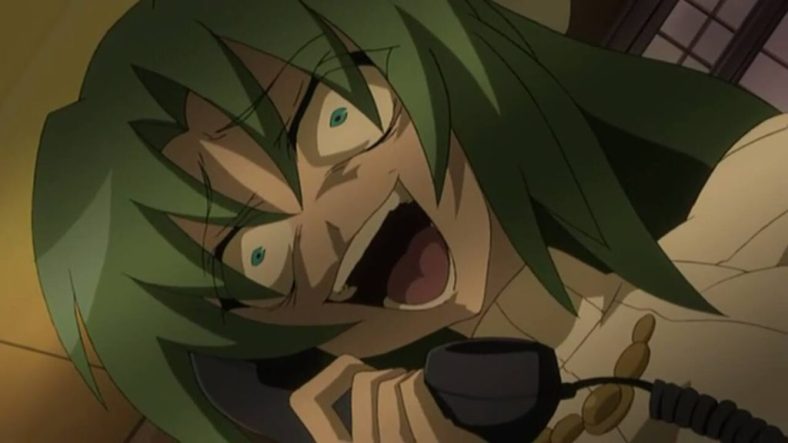Curses and Bloodshed: Underrated Horror Anime ‘When They Cry’ Is A Must-Watch

Horror exists in so many different forms and mediums. It’s nearly impossible to grow tired of the genre. If movies aren’t scary like they used to be, there are always games. The Mortuary Assistant will more than satisfy the jump scare quotient. There are novels, of course, including some sensational non-fiction reads like Bob Mielke’s Threads. Then there’s horror anime. Hell’s Paradise is an absolute banger, of course, but this summer, whether you’re an old fan or new, there’s no denying When They Cry (Higurashi no Naku Koro ni) is the anime to watch.
First released in 2006, When They Cry is as opaque as it is terrifying. Though the barrier to entry is arguably higher than most horror anime, patience and a willingness to grapple with the nebulous proves to be a virtue as Ryukishi07’s (the original creator) accursed saga unfurls. When They Cry is part of a much larger universe, one that encompasses video games, OVAs (including When They Cry: Rei, discussed here), and dōjin soft, the Japanese equivalent of self-published indie games. Timelines are varied, though rather than unpacking the full When They Cry universe, the focus here will be on the first three series: When They Cry, When They Cry: Kai (Higurashi no Naku Koro ni Kai), and When They Cry: Rei (Higurashi no Naku Koro ni Rei).
Also Read: ‘Hell’s Paradise’ Voice Actors Marisa Duran and Alejandro Saab Talk Body Horror And Love [Watch]
When They Cry, the first of the series, aired in 2006, with Kai following in 2007, and Rei releasing as a brief, five-episode OVA in 2009. Split into six chapters ranging from two to six episodes, the broad outline follows a group of young friends grappling with mysterious goings-on in the rural village of Hinamizawa. Keiichi Maebara (Sôichirô Hoshi) is the audience entry point, a new arrival to the village and the sole male presence among a pre-ordained group of young women. They include the mysterious Mion Sonozaki (Satsuki Yukino), the adorable Rena Ryugu (Mai Nakahara), the spiritual Rika Furude (Yukari Tamura), and the sensitive Satoko Hojo (Mika Kanai).
While I won’t spoil the sundry twists and developments, including key character arcs and backgrounds, suffice it to say none of the ostensibly chipper, cutesy main characters are quite what they seem. That the first arc chapter, “Spirited Away by the Demon,” ends in shocking violence involving the main characters might seem subversive. But even more distressing is that, by the start of the following chapter, “The Cotton Drifting,” everything has been reset.
Also Read: This Unmissable New Horror Series Takes You On A Trip into Hell
It’s less that the events are being retold, and more like a dovetailing timeline with the same broad sketch of Hinamizawa mayhem unfolding to cue viewers into more details and theories regarding local deity Oyashiro-sama’s curse. Every year on the night of the Cotton Drifting Festival, a town resident dies while another goes missing. Keiichi Maebara’s recognition of the pattern in the first arc is the strongest guiding thread through When They Cry’s mystery. The series is regularly aloof, both suggesting and discounting—often at the same time—whether the mysterious deaths are the result of something supernatural or someone in town.
That’s principally what viewers are tasked with piecing together. As insight is expanded and the body count rises, once innocuous interactions are rendered sinister. With a new perspective, an early, incongruous beat of dialogue might make perfect sense when seen from another vantage point several episodes later. It helps that the opening title song intentionally back masks the phrase “nigerarenai,” roughly translating to “can’t escape.”
Also Read: ‘Chainsaw Man’ Delivers A Bloody Good Time [Review]
Audiences won’t be able to escape. While the melding of the cutesy anime aesthetic with graphic horror violence (and trust me, When They Cry can get graphic) might seem like less of a novelty today with releases like Doki Doki Literature Club!, it was a marvel at the time. Truthfully, the efficacy of the juxtaposition holds up, augmenting the future violence with an earnestly effervescent core cast. At the conclusion of the first episode, viewers would be forgiven for thinking they’d mistakenly streamed a slice-of-life anime. Entire beats unfurl without any horror, rendering the eventual bloodshed all the more distressing.
Higurashi When They Cry is arguably the strongest of the chapters, though the sequel series When They Cry: Kai and When They Cry: Rei are a must for viewers to fully (or mostly) understand the breadth of the curse and threat plaguing Hinamizawa. Like the best of what Japanese horror has offered this century, Higurashi When They Cry is cursed ground. Deeply spiritual, graphically violent, and beguilingly mysterious, it’s must-watch television for horror fans everywhere. This summer, when the cicadas start to cry, you just might sense someone—or something—walking right behind you.
Categorized:Editorials

